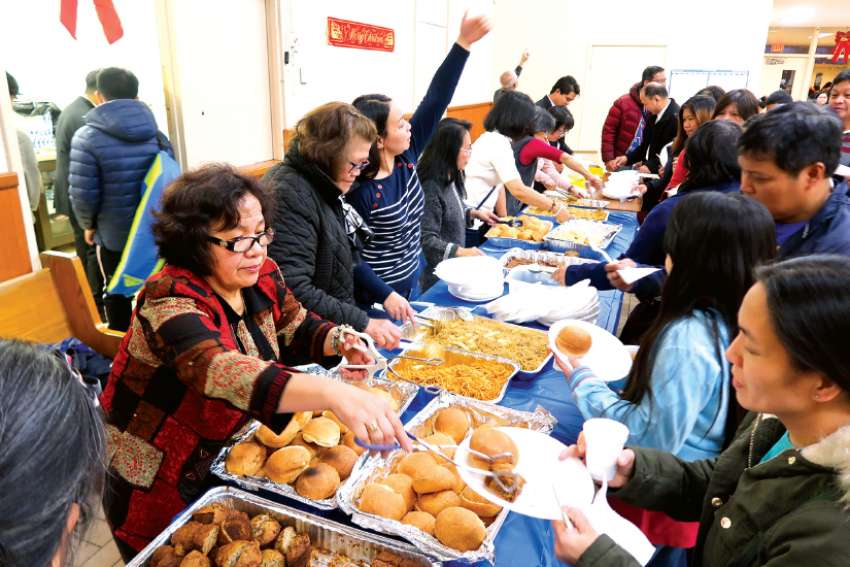To say it was far removed from his own Christmas experience growing up Saint John, N.B., would be an understatement.
As one of a group of visiting Jesuit scholastics, Sullivan was serving the rural mountain region of Banale during the Christmas season. He would wake up every day at around 4 a.m. to get ready for 5 a.m. Mass for the farming community before they started their day in the rice fields.
“I could look out my window and all you can see is black but then I could see these little dots of light coming down the mountain,” he said. “It was all these people with flashlights, walking down the mountain in pitch black, in flip flops, to come for Simbang Gabi.”
Simbang Gabi, or “Night Mass,” is the central part of Christmas celebrations in the Philippines. It is a nine-day devotional series of Masses that is slowly becoming a part of Canadian parishes as well.
Traditionally, Filipinos gathered at church from as early as 3-5 a.m. for Mass every day from Dec. 16 to 24. Unlike regular Masses during the Advent season, these Masses are celebrated with great solemnity and the “Gloria” is sung. White is the liturgical colour priests wear to celebrate these novena Masses, unlike the purple vestments that are used for other Masses during the Advent season.
After the service, there is a feast where parishioners bring traditional dishes to share with the community.
“They used to say you start preparing (for Christmas) in the ‘ber’ months and as a Canadian, I thought they meant like, ‘Brr, it’s cold outside.’ But they mean September, October, November and December,” he said.
Sullivan said the local villagers would walk for hours to the chapel so they could attend Simbang Gabi before sunrise. One woman told him that she would walk eight hours from her house to the chapel for Mass, which meant that she would have to rearrange her sleep schedule so she could attend.
He was so amazed by the faith of the Filipinos he served in Banale that when he came to Our Lady of Lourdes parish in Toronto, he worked with the Filipino parishioners to bring the tradition to their community.
“The main difference between my experience in Canada and that in the Philippines is the more communal festivity, through the Novena Masses, with its accompanying communal joy,” he said. “Christmas was definitely a family time, whereas the Novena Masses allow that to easily extend to an excitement and expectation that is overtly shared with members of the faith community.”
Simbang Gabi is now celebrated in Canadian parishes across the country, typically in the evenings, from Dec. 15-23.
The number of Filipinos in Canada has doubled in the last decade to about 850,000 and while their population grows, so does their influence on the Canadian mosaic.
It was still summertime when Vancouver Archbishop J. Michael Miller started encouraging churchgoers to think about new ways to embrace Christmas this year.
In particular, he encouraged local Catholic parishes to embrace the Filipino community’s “beautiful gift” of Simbang Gabi.
“It is my hope that Simbang Gabi will be embraced by the faithful beyond the Filipino community as a fitting way of preparing for Christmas,” Miller wrote in a letter to pastors July 17.
The tradition of Simbang Gabi originated in the early days of Spanish colonial times in the country. Similar to the rest of the Hispanic world, the country adopted the custom of evening novenas in preparation for Christmas.
In the 1600s, priests began to celebrate Mass in the early mornings as a practical compromise for the farmers who began work in the fields before sunrise to avoid the noonday heat. Parishioners wouldn’t have anything to offer during Mass except for the crops of their labour, which was often sacks of rice, fruits, vegetables and fresh eggs.
These gifts were graciously accepted by the priests, who would keep a portion for themselves and share the rest with the congregation after the service. Filipinos would gather together to cook breakfast together with food, like arroz caldo (rice porridge), bibinka (rice cakes) and kape barako (very strong coffee from Batangas region). The rice-based foods were served to fill the stomachs of the farmers before they went out to work in the rice fields and sugar cane mills.
“The purpose was to evangelize the farmer, who wakes up early and starts work,” said Homer Reyes, a parishioner who celebrates Simbang Gabi at Our Lady of Good Counsel parish in Surrey, B.C. “We started to adapt the tradition here. In the modern world, it is to expand the devotion to Mary, who is bringing the Messiah, called Emmanuel.”
Reyes said having Simbang Gabi at his local parish keeps the tradition and history of the Filipino Church alive for the immigrants who now live in Canada. He has even noticed an increasing number of non-Filipino parishioners at Simbang Gabi, including those who attend the church’s Indo-Canadian, Laotian, Polish and Spanish Masses.
Sullivan said he hopes Simbang Gabi will become an evangelization tool to spread the joyful anticipation Filipinos have during the Advent season to all parishioners.
“I think in general, people who have come who didn’t grow up with the tradition have really enjoyed it,” he said. “It’s just seeing people with a joy in their faith, to see the real, uninhibited joy they have in Jesus Christ.”
(With files from B.C. Catholic)


